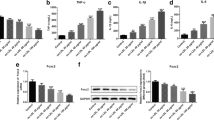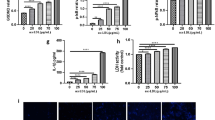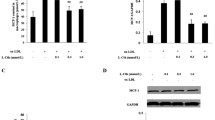Abstract
Aim
To study the relationship between Daxx expression and the antiapoptotic effects of probucol in THP-1 macrophage.
Materials and methods
Apoptosis of THP-1 derived macrophages was induced by exposure to oxidized low density lipoprotein (oxLDL). The development of apoptosis was determined by flow cytometry analysis and nucleic acid-binding dye acridin orange. Reverse transcriptase-polymerase chain reaction (RT-PCR), Western blotting and indirect immunofluorescence were used to evaluate the expression of Daxx and caspase-3 at both mRNA and protein level.
Results
As expected, THP-1 macrophages exposed to 100 mg/l oxLDL for 48 h exhibited typical morphologic changes of apoptosis, including condensed chromatin and shrunken nucleus. oxLDL treatment markedly increased Daxx expression in a time- and dose-dependent manner, and facilitated Daxx translocation from cytoplasm to nucleus. The percentage of cells with Daxx in nuclei was significantly increased from 8 to 59%. Treatment with probucol (50 μmol/l) for 4 h prior to exposure to oxLDL significantly inhibited Daxx expression and THP-1 macrophage apoptosis by 61.3%. Furthermore, oxLDL enhanced caspase-3 expression with increased mRNA and protein levels, but without obvious change in translocation of caspase-3 (the cells with nuclear Daxx: 14 vs 8%). In contrast, probucol attenuated oxLDL-stimulated caspase-3 expression in THP-1 macrophages.
Conclusion
OxLDL-induced apoptosis of THP-1 macrophage is associated with Daxx up-regulation; while inhibition of apoptosis by probucol is related to decreased Daxx expression and nuclear translocation.








Similar content being viewed by others
References
Littlewood TD, Bennet MR. Apoptotic cell death in atherosclerosis. Curr Opin Lipidol 2003;14 5:469–75.
Stoneman VE, Bennett MR. Role of apoptosis in atherosclerosis and its therapeutic implications. Clin Sci 2004;107 4:343–54.
Kolodgie FD, Narula J, Haider N, Virmani R. Apoptosis in atherosclerosis. Does it contribute to plaque instability? Cardiol Clin 2001;19 1:127–39.
Best PJM, Hasdai D, Sangiorgi G, Schwartz RS, Holmes DR, Simari JRD, et al. Apoptosis: basic concepts and implication in coronary artery disease. Arterioscler Thromb Vasc Biol 1999;19 1:14–22.
Jiang P, Yan PK, Chen JX, Zhu BY, Lei XY, Yin WD, et al. HDL3 inhibit Ox-LDL-induced apoptosis by promoting cholesterol efflux in RAW264.7 cells. Acta Pharmacol Sin 2006;27 2:151–7.
Wintergerst ES, Jelk J, Rahner C, Asmis R. Apoptosis induced by oxidized low density lipoprotein in human monocyte-derived macrophages involves CD36 and activation of caspase-3. Eur J Biochem 2000;267 19:6050–9.
Yao PM, Tabas I. Free cholesterol loading of macrophages induces apoptosis involving the Fas pathway. J Biol Chem 2000;275 31:23807–13.
Metzler B, Hu YH, Dietrich H, Xu QB. Increased expression and activation of stress-activated protein kinases/c-Jun NH2-terminal protein kinases in atherosclerotic lesions coincide with p53. Am J Pathol 2000;156 6:1875–86.
Asmis R, Begley JG. Oxidized LDL promotes peroxide-mediated mitochondrial dysfunction and cell death in human macrophages: a caspase-3-independent pathway. Circ Res 2003;92 1:20–9.
Buckley MM, Goa KL, Price AH, Brogden RN. Probucol, a reappraisal of its pharmacological properties and therapeutic use in hypercholesterolaemia. Drugs 1989;37 6:761–800.
Aoki M, Nata T, Morishita R, Matsushita H, Nakagami H, Yamamoto K, et al. Endothelial apoptosis induced by oxidative stress through activation of NF-κB: antiapoptotic effect of antioxidant agents on endothelial cells. Hypertension 2001;38 1:48–55.
Ceaser EK, Ramachandran A, Levonen AL, Darley-Usmar VM. Oxidized low-density lipoprotein and 15-deoxy-Δ12,14-PGJ2 increase mitochondrial complex I activity in endothelial cells. Am J Physiol Heart Circ Physiol 2003;285 6:2298–308.
Liu GX, Ou DM, Liu JH, Huang HL, Liao DF. Probucol inhibits lipid peroxidation of macrophage and affects secretory properties of macrophage. Acta Pharmacol Sin 2000;21 7:637–40.
Hung HH, Chen YL, Lin SJ, Yang SP, Shih CC, MS Shiao, et al. A salvianolic acid B-rich fraction of salvia miltiorrhiza induces neointimal cell apoptosis in rabbit angioplasty model. Histol Histopathol 2001;16 1:175–83.
Yang X, Far RK, Chang HY, Baltimore D. Daxx, a novel Fas-binding protein that activates JNK and apoptosis. Cell 1997;89 7:1067–76.
Chang HY, Nishitoh H, Yang XL, Ichijo H, Baltimore D. Activation of apoptosis signal-regulating kinase 1 (ASK1) by the adapter protein Daxx. Science 1998;281 5384:1860–3.
Tobiume K, Matsuzawa A, Takahashi T, Nishitoh H, Morita KI, Takeda K, et al. ASK1 is required for sustained activations of JNK/p38 MAP kinases and apoptosis. EMBO J 2001;2 3:222–8.
Wu S, Loke HN, Rehemtulla A. Ultraviolet radiation-induced apoptosis is mediated by Daxx. Neoplasia 2002;4 6:486–92.
Song JJ, Lee YJ. Daxx deletion mutant (amino acids 501-625)-induced apoptosis occurs through the JNK/p38-Bax-dependent mitochondrial pathway. J Cell Biochem 2004;92 6:1257–70.
Su B, Wan YP, Liao DF. Expression of death-associated protein in monocyte-derived macrophages and ECV304 endothelial cells. Chin J Arterioscler 2004;12 2:162–4.
Li LX, Chen JX, Liao DF, Yu L. Probucol inhibits oxidized-low density lipoprotein induced adhesion of monocytes to endothelial cells by reducing p-selectin synthesis in vitro. Endothelium 1998;6 1:1–8.
Niu XL, Zhang XW, Guo ZG. Oxidized low-density lipoproteins induce apoptosis in macrophages. Acta Pharmacol Sin 1996;17 5:467–70.
Torii S, Egan DA, Evans RA, Reed JC. Human Daxx regulates Fas-induced apoptosis from nuclear PML oncogenic domains (PODs). EMBO J 1999;18 21:6037–49.
Ishov AM, Sotnikov AG, Negorev D, Vladimirova OV, Neff N, Kamitani T, et al. PML is critical for ND10 formation and recruits the PML-interacting protein Daxx to this nuclear structure when modified by SUMO-1. J Cell Biol 1999;147 2:221–34.
Li H, Leo C, Zhu J, Wu X, O’Neil J, Park EJ, et al. Sequestration and inhibition of Daxx-mediated transcriptional repression by PML. Mol Cell Biol 2000;20 5:1784–96.
Song JJ, Lee YJ. Role of the ASK1-SEK1-JNK1-HIPK1 signal in Daxx trafficking and ASK1 oligomerization. J Biol Chem 2003;278 47:47245–52.
Song JJ, Lee YJ. Catalase, but not MnSOD, inhibits glucose prevents relocalization of Daxx: hydrogen peroxide as a major second deprivation-activated ASK1-MEK-MAPK signal transduction pathway and messenger of metabolic oxidative stress. J Cell Biochem 2003;90 2:304–14.
Zhong S, Salomoni P, Ronchetti S, Guo A, Ruggero D, Pandolfi PP. Promyelocytic leukemia protein (PML) and Daxx participate in a novel nuclear pathway for apoptosis. J Exp Med 2000;191 4:631–40.
Chen LY, Chen JD. Daxx silencing sensitizes cells to multiple apoptotic pathways. Mol Cell Biol 2003;23 20:7108–21.
Michaelson JS, Leder P. RNAi reveals anti-apoptotic and transcriptionally repressive activities of DAXX. J Cell Sci 2003;116 2:345–52.
Michaelson JS. The Daxx enigma. Apoptosis 2000;5 3:217–20.
Cermák L, Símová S, Pintzas A, Horejsí V, Andera L. Molecular mechanisms involved in CD43-mediated apoptosis of TF-1 cells. Roles of transcription, Daxx expression, and adhesion molecules. J Biol Chem 2002;277 10:7955–61.
Chen J, Mehta JL, Haider N, Zhang X, Narula J, Li D. Role of caspases in Ox-LDL-induced apoptotic cascade in human coronary artery endothelial cells. Circ Res 2004;94 3:269–70.
Nhan TQ, Liles WC, Chait A, Fallon JT, Schwartz SM. The p17 cleaved form of caspase-3 is present within viable macrophages in vitro and in atherosclerotic plaque. Arterioscler Thromb Vasc Biol 2003;23 7:1276–82.
Boehrer S, Nowak D, Hochmuth S, Kim SZ, Trepohl B, Afkir A, et al. Daxx overexpression in T-lymphoblastic Jurkat cells enhances caspase-dependent death receptor- and drug-induced apoptosis in distinct ways. Cell Signal 2005;17 5:581–95.34.
Dai Z, Liao DF, Jiang DJ, Deng HW, Li YJ. 3,4,5,6-Tetrahydroxyxanthone prevents vascular endothelial cell apoptosis induced by high glucose. Naunyn Schmiedebergs Arch Pharmacol 2004;370 4:314–9.
Sia YT, Lapointe N, Parker TG, Tsoporis JN, Deschepper CF, Calderone A, et al. Beneficial effects of long-term use of the antioxidant probucol in heart failure in the rat. Circulation 2002;105 21:2549–55.
Kim DS, Kim HR, Woo ER, Kwon DY, Kim MS, Chae SW, et al. Protective effect of calceolarioside on adriamycin-induced cardiomyocyte toxicity. Eur J Pharmacol 2006;541 1–2:24–32.
Li WG, Coppey L, Weiss RM, Oskarsson HJ. Antioxidant therapy attenuates JNK activation and apoptosis in the remote noninfarcted myocardium after large myocardial infarction. Biochem Biophys Res Commun 2001;280 1:353–7.
Oskarsson HJ, Coppey L, Weiss RM, Li WG. Antioxidants attenuate myocyte apoptosis in the remote non-infarcted myocardium following large myocardial infarction. Cardiovasc Res 2000;45 3:679–87.
Lou H, Danelisen I, Singal PK. Involvement of mitogen-activated protein kinases in adriamycin-induced cardiomyopathy. Am J Physiol Heart Circ Physiol 2005;2884:H1925–930.
Kumar D, Kirshenbaum LA, Li T, Danelisen I, Singal PK. Apoptosis in adriamycin cardiomyopathy and its modulation by probucol. Antioxid Redox Signal 2001;31:135–45.
Bachem MG, Wendelin D, Schneiderhan W, Haug C, Zorn U, Gross HJ, et al. Depending on their concentration oxidized low density lipoproteins stimulate extracellular matrix synthesis or induce apoptosis in human coronary artery smooth muscle cells. Clin Chem Lab Med 1999;373:319–26.
Acknowledgments
The authors are indebted to Dr. Li-Xin Li (Oregon University, USA), Dr. He-Sheng Ou (Baylor College of Medicine, USA) and Dr. Zhen-Gao Liu (Ohio State University, USA) for their critical discussions, suggestions, and valuable help in the preparation of the manuscript. This work was supported by the National Natural Science Foundation of China (30470719, 30600249), the National Major Basic Research Program of China (973) (2006CB503808), and the Education Department of Hunan Province (99B11).
Author information
Authors and Affiliations
Corresponding author
Additional information
Bo Su and Yun-Bo Yang equally contributed to this paper.
Rights and permissions
About this article
Cite this article
Su, B., Yang, YB., Tuo, QH. et al. Anti-apoptotic Effects of Probucol are Associated with Downregulation of Daxx Expression in THP-1 Macrophage. Cardiovasc Drugs Ther 21, 37–45 (2007). https://doi.org/10.1007/s10557-007-6002-x
Received:
Accepted:
Published:
Issue Date:
DOI: https://doi.org/10.1007/s10557-007-6002-x




